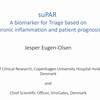2´nd International suPAR Symposium
suPARnostic See all
2’nd International suPAR Symposium
The 2nd International Conference on suPAR” was taking place in early spring 2011 at the Danish National Museum in Copenhagen.
The 1st International conference on suPAR” in 2003 shared findings on suPAR as a marker of disease progression and survival in HIV and TB infected. Since then, suPAR has been broadly applied to a range of diseases and the same picture is emerging. An elevated suPAR is associated with a negative prognosis independent of disease. Even among the general population, an elevated suPAR has recently been shown to be associated with increased risk of diseases such as cardiovascular disease, cancer and Type 2 Diabetes.
But what does an elevated suPAR reflect? The suPAR level is positively correlated with markers of inflammation and immune activation such as CRP (hsCRP), TNF-a and white blood cell counts. Thus, suPAR may be a novel marker of inflammation, and increased inflammation has in recent years been suggested as a disease driving mechanism. Nevertheless, suPAR remains associated with disease endpoints after the adjustment of other inflammatory markers and is less related to metabolic variables than CRP. Thus suPAR may reflect another aspect of inflammation than the classical markers do.
A large number of studies are currently investigating the role of suPAR in a wide variety of conditions, and this conference will bring forward the newest data which will further enlighten the role and possible applications of this biomarker.
Purpose and Scope
The suPAR (soluble urokinase Plasminogen Activator Receptor) protein is a relatively new biomarker which has ability to predict severity of illness and mortality. The prognostic value of suPAR has been described in published studies in recent years and is currently being tested in several health care applications.
The symposium aim is to bring together researchers, users and other persons to discuss the features and potential usability of the suPAR protein as a biomarker and will:
◦ Provide a forum to learn about new findings and current suPAR studies
◦ Host a scientific community discussion on the new opportunities that exist with a prognostic biomarker
◦ Hear from the delegates what questions, feed-back and ideas for suPAR applications and user requirements
◦ Facilitate foundation for international net-working
Preliminary Agenda
◦ Session 1: suPAR and 10-year risk in the General Population
◦ Session 2: suPAR and Prognosis in Infectious Diseases
◦ Session 3: suPAR as a Risk Biomarker in the Intensive Care Unit
◦ Session 4: Decreasing suPAR Concentration – Impact on survival?
◦ Session 5: Is there a Role for suPAR in Disease Risk Management?
◦
suPARnostic See all
Dr Eugen-Olsen talks on chronic inflammation and how it is linked to the...
|
|||||










































































































